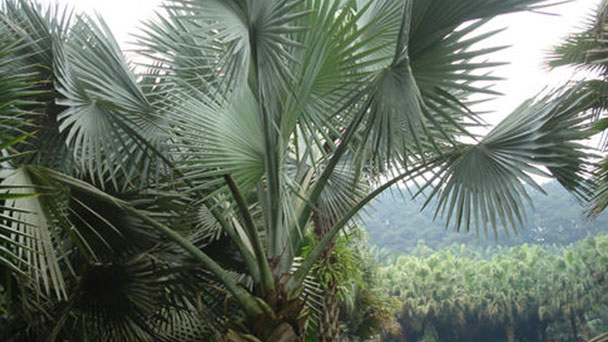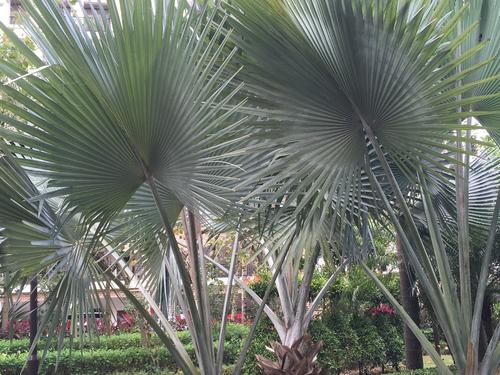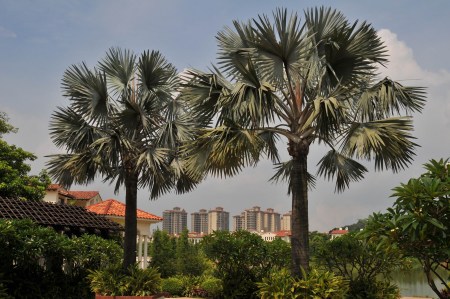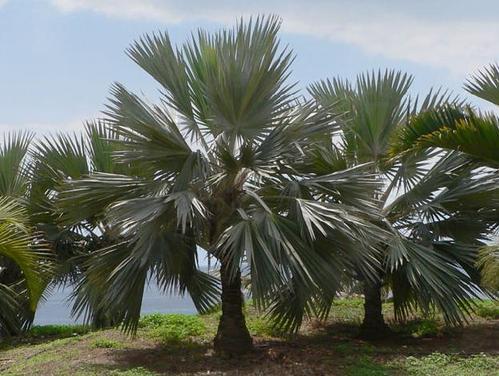Bismarck palm (Bismarckia nobilis) profile
Written by Maggie
Mar 26 2021

Bismarck palm(Bismarckia nobilis) is a rare species in the palm family. Bismarck palm plants are tall and can reach 30 m or more, and can reach 70~80 m in their native place of origin. Stem is smooth, firm, grayish green. The leaves are huge, about 3 meters long, fan-shaped, multi-lobed, blue-gray. Bismarck palm is tall and spectacular and grows rapidly. It likes sunny, warm climates and a well-drained growing environment.
Bismarck palm picture

Morphological characteristics of Bismarck palm
Bismarck palms are tall and can reach 30 meters or more, 70 to 80 meters in their native place of origin. Stem is smooth, firm, grayish green. The leaves are huge, about 3 meters long, fan-shaped, multi-lobed, blue-gray. Dioecious, spikes; Female inflorescences are shorter and stout; Male inflorescences are longer, branched. Seeds are large, subglobose, dark brown. There are also green leaf varieties commonly cultivated.
The fruit of Bismarck palm is drupe. Its seed body is large, the single seed weight is 14 ~ 17 grams, and the seed shell is firm and thick. There are 3 holes at the base of the seed, of which the L hole is opposite to the embryo, through which the radicle shoots out when germination, and the other 2 holes are pseudopolis. The endosperm of the fruit cavity contains rich nutrients which are absorbed during seed germination.
Ecological habits of Bismarck palm
Bismarck palm is tall and spectacular and grows rapidly. It likes sunny, warm climates and a well-drained growing environment. Bismarck palm is drought and cold resistant. Bismarck palm plants have strong adaptability, like fertile soil, endure barren, and not strict requirements on soil. However, in order to avoid the occurrence of "transplant dementia", the adult plant should be transplanted with an intact soil bulb, and the soil bulb should be longer and larger than the common palm plant.
The distribution of Bismarck palm
Bismarck palm is native to the savanna region of western Madagascar. After being introduced into China, it has been cultivated well in South China. Bismarck palm grows well in inland tropical and subtropical areas.
How to grow and care for Bismarck palm
Size and growth
In its native habitat in Madagascar, Bismarck palm can develop shut to 75′ ft tall.
Cultivated Bismarck hands hardly ever exceed 25′ feet. The tree grows from a single trunk, included in grey or tan bark.
The trunks can also attain 12″ to 18″ inches in diameter, with a mild bulge close to the base.
The trunks don't have leaf bases.
The leaves are frequently silver-blue and develop to various feet.
The rounded leaves function more than one blade, akin to a frond.
The leaves shape a nearly spherical crown, measuring about 20′ ft large and 18′ ft tall, relying on the measurement of the trunk.
Flowering
Bismarck palm plant life in the spring or summer, producing pendant inflorescences with small brown flowers.
On lady plants, Bismarck palm ultimately matures and improves into a brown fruit containing a single seed.
Light and temperature
Bismarck palm ought to get hold of full solar to partial shade.
Bismarck palm requires heat temperatures and loads of sunlight.
It's wintry weather hardy to USDA hardiness zones 9 or higher, making it hard to develop outside the backyard of Florida and California.
The popular Bismarck palm with blue-silver foliage can't tolerate temperatures under 27° ranges Fahrenheit (-3° C).
It may also cause frost injury in cooler climates.
The green range is barely extra tolerant of bloodless temperatures.
The leaves of the plant may also go through in temperatures under 32° stages Fahrenheit (0° C).
Watering and fertilizer
Bismarck palm bushes develop first-class in climates with regularly occurring rainfall.
While it tolerates quick durations of drought, it flourishes with ordinary moisture.
Water the soil round the base of the trunk, offering moisture immediately to the root system. Once hooked up the plant hardly ever wants palm fertilizer.
Soil and transplanting
Slightly alkaline or acidic soil is pleasant however wants appropriate drainage to forestall root rot.
Transplanting isn’t encouraged due to the viable measurement of the plant.
Cultivated Bismarck palm timber can also nonetheless reach 20′ toes tall with leaves spreading 12′ toes or more.
Bismarck palm timber additionally has refined root systems. Attempting to transplant the plant may additionally damage the roots.
Transplanting is only encouraged for dealing with disease, such as root rot. Prune the leaves lower back for various months earlier than transplanting.

How to propagate Bismarck palm
Propagate Bismarck palm from seed after the seeds are gathered from lady flowers when the fruit ripens.
Soak the seeds in a thermos stuffed with warm water. Allow the seeds to soak for two days at 86° ranges Fahrenheit (30° C) water.
Prepare small 4″ inch pots with an equal aggregate of coarse sand and widespread potting soil.
Moisten the soil earlier than gently urgent one seed into every pot.
Press the seeds 1″ inch into the soil.
Keep the pots in a shaded, heat spot.
Check the soil day by day and add water as wanted to maintain it moist.
The seeds have to germinate inside six to eight weeks.
The seedlings are prepared to plant when they increase a 2nd set of leaves.
Plant the seeds in pots and later outside in a place with full sun.
Ensure the Bismarck palm life has sufficient room to unfold as they grow, as the crown can attain 12′ to 20′ ft wide.
Disease control of Bismarck palm
Spray from the initial stage of the disease to prevent the spread of disease. Commonly used agents are 20% silazole-imitamine 1000 times solution, 38% oxapuropyritin 800-1000 times solution or 4% fluosilazole 1000 times solution, 50% tobuzine 1000 times solution, 70% dioxin manganese 500 times, 80% dioxin manganese 400-600 times solution, 50% carbendane 500 times and so on.Care must be taken to alternate the use of drugs so that the bacteria do not develop resistance.
Landscape use of Bismarck palm
Bismarck palm is a rare species in the palm family due to its huge plant shape, firm palm leaves and unique leaf color. It is a beautiful and unique tree posture, trunk straight, elegant leaves, loved by people. In recent years, because of its excellent ornamental effect, a person with the feeling of "overbearing full", aroused the interest of the majority of garden lovers and the attention of the nursery producers, have introduced production and greening application. The tree shape is tall and straight, the leaf is huge, forms the broad tree crown, for the precious and the famous ornamental palm, is suitable for the garden cultivation, for the ornamental.

Latest Updated
- Benefits of Bugleweed - 7 Science-backed Health Benefits
- Bugleweed Dangers & Side Effects - Is It Poisonous?
- How to Plant Evergreen Trees - What You Should Know
- When to Plant Evergreens - Grow Guide for Evergreen Trees
- 12 Wonderful Evergreen Shrubs for Your Garden
- 12 Popular Evergreen Plants with Pictures for Beginners
- When And How To Prune A Lilac Bush Like a Pro
- How to Grow & Care for Lilac Vine (Hardenbergia Violacea)
- Japanese Lilac Tree (Syringa Reticulata) Care & Propagation Guide
- Shumard Oak Pros and Cons - What to Know
Popular Articles
- Winter maintenance of Antirrhinum Majus
- How to Grow Terminalia Mantaly Tree
- How to Grow and Care for Crossostephium Chinense
- How to grow Antirrhinum Majus in spring
- Peristeria Elata (Dove Orchid) Profile: Info & Care Guide
- Underwatered Snake Plant (Sansevieria Trifasciata) - Signs And How To Fix
- How to Care for Brazilian Jasmine Plant (Mandevilla Sanderi)
- How to Grow & Care for Graptopetalum Purple Delight in Summer
- Rosa Chinensis (China Rose): Plant Growing & Care Tips
- How to Care for Baby Sun Rose (Aptenia Cordifolia)